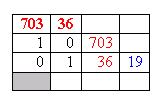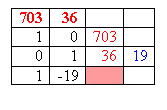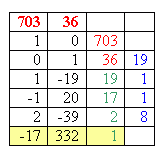 |
 |
|
From: Geecee At a local village gala, the entire population turned up, 500 people. The event raised £3,000. Tickets were priced as follows: £7.48 men, £7.12 women and £0.45 children.
|
||||||||||||||||
|
Hi Geecee. First let's look at how the people add up. Let's use m, w and c to represent the number of men, women and children:
Now let's write out the receipts (converting things to whole numbers by multiplying first by 100): Substitute in our earlier evaluation of m and then simplify:
Now there are some important facts about this last expression: w and c are both whole numbers and are between 0 and 500. What fits? For this, we'll use the Euclidean Algorithm. The Euclidean Algorithm will help us find w and c. We already can see that 36 and 703 are relatively prime, so we know the GCD is 1, but if we use the Euclidean Algorithm, we'll be able to see a general form for all the integers that fit into 74 000 = 36w + 703c. Here's a neat notation method for using the Euclidean Algorithm. One of our experts here at Math Central (Penny) taught it to me and I thought I'd pass it along to you. The method just keeps track of things neatly and quickly. The way it works is as follows:
We are really interested in 703c + 36w = 74 000, so let's multiply by 74 000:
So far, these numbers look enormous! But don't give up yet - obviously the number of women isn't -1 258 000. But we can create a general form for this equation. What happens if we choose some arbitrary integer k and add 36k to the first set of parentheses? We've added (703)(36)k to one side of the equation, so we either need to add it to the other side or subtract it again. Let's subtract it again by putting -703k into the second set of parentheses: This works for any integer value of k! What we want to find is a k that gives us a suitable w and c. Let's summarize what we know:
So then c = 36k - 1 258 000 and w = 24 568 000 - 703k for some special value of k. Let's use w's domain restriction to determine k:
But since k is an integer, there is only one possible value for k: 34 947. Now that we know k, we can solve for c: 36k - 1 258 000 = 36(34 947) - 1 258 000 = 92. This is certainly between 0 and 500. So we have an answer. To check our answer, let's calculate the number of men and women and make sure everything is right.
Both of these numbers are also between 0 and 500. For the final step in our check, let's put these numbers into the receipts and see if we get £3 000: Stephen La Rocque.>
|
||||||||||||||||
 |
 |
 |




